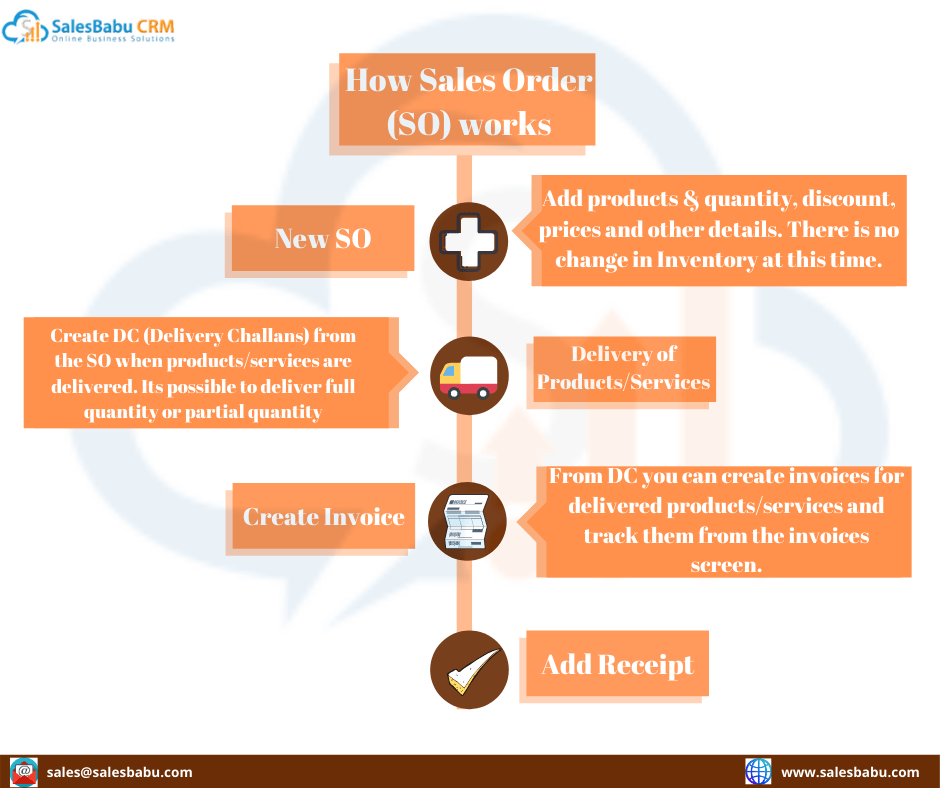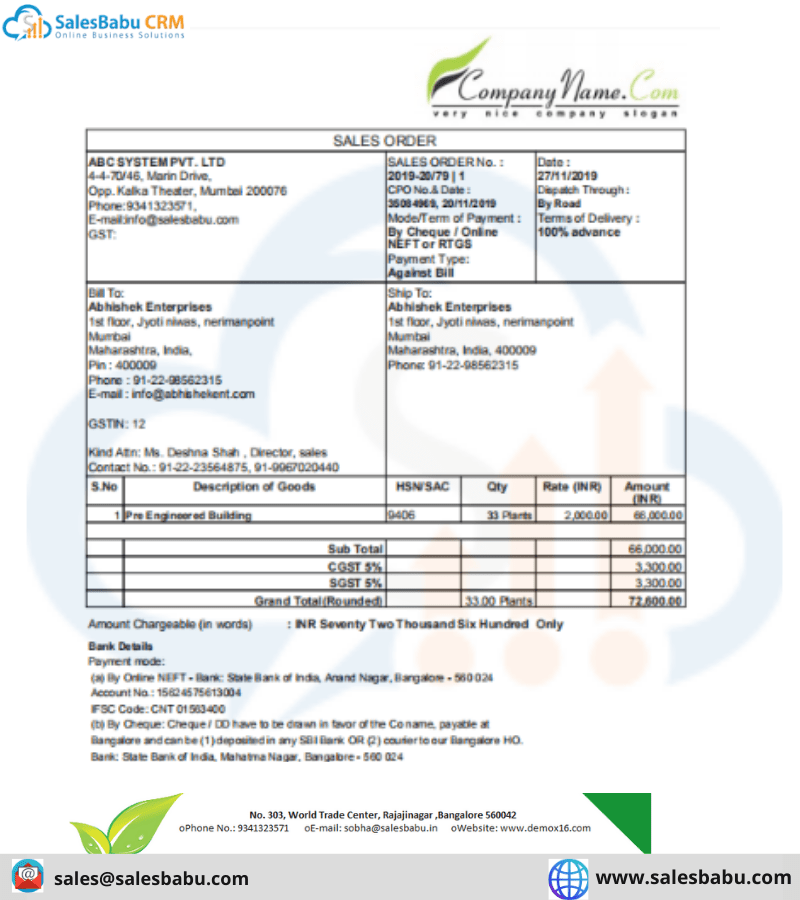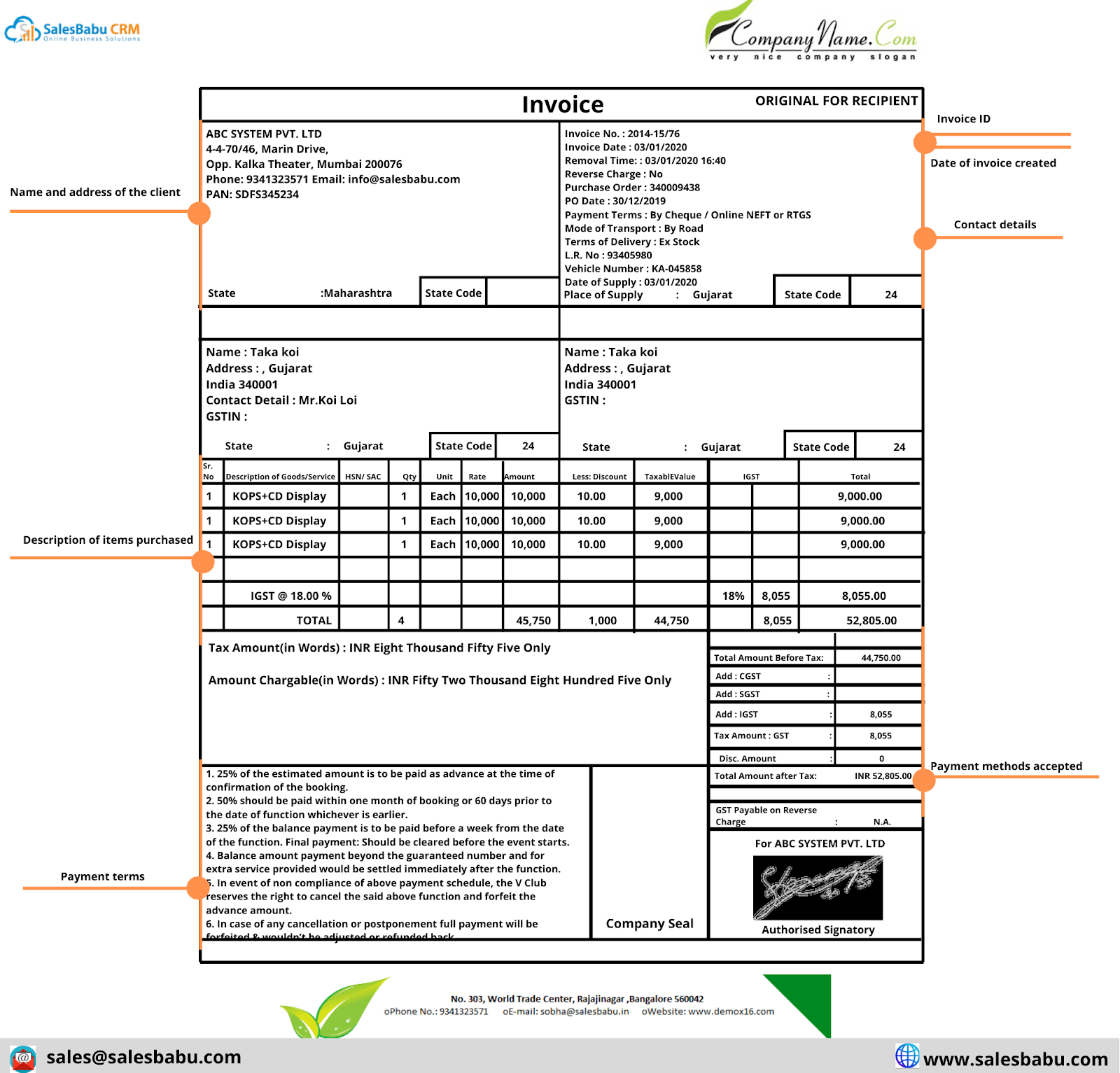The sales order, quotations, purchase orders, sales pre-invoices and post-invoices are some of the wide range of varieties of documents used in the entire sales process. The sales order and invoice are the two major tools for order tracking and play a major role in the business transactions.
Let us have a detailed look at the differences between sales order and invoice –
What is Sales Order and Invoice?
Sales Order
A sales order is a commercial document that originates with the customer as he/she is making the purchase. It is essentially a request for a product or service which ultimately will become a receipt.
Invoice
A sales invoice is a commercial document delivered after the products have been delivered or the services have been rendered.
What are the steps involved in creation of Sales Order and Invoice in the business flow?
Businesses follow these steps to create a Sales Order –
- The seller sends a sales quote to the customer.
- If SO is accepted, then the customer sends the seller a purchase order.
- The seller creates a SO based on the purchase order from the customer.
- The customer may request a SO to view the specific details of the products, price, terms and delivery dates, billing/shipping address.
Businesses follow these steps to create an invoice from a sales order –
- After the products are shipped by the seller, they create an invoice from the sales order (SO).
How does Sales Order and Invoice work in the sales process?
Sales Order
The sales order confirms the sale and is generated after the sales quote has been accepted by both parties. It confirms the purchase in the form of a legal document.
Invoice
Invoice is created from sales order and it signifies the amount due on the list of products or services and payment terms, conditions provided by the seller or the vendor. This bill is sent to the customer before the product or service is delivered to the customer.

What does Sales Order and Invoice contain?
Sales order
A sales order contains –

- Customer name : The sales order contains the customer name and details including address, contact details etc.
- Date of sales order : The sales order indicates the date on which the customer’s request has been processed.
- Product name, description, quantity, unit cost, discounts, additional charges etc. : The entire detailed information with regard to product name, product description, cost and additional discounts etc are provided in the sales order.
Invoice
The invoice contains –

- Name and address of the client : The name and address of the client is mentioned in the invoice.
- Date of invoice created : The date of invoice created is usually on the date when the product or services have been billed. The due date of the invoice is also mentioned in order to prompt the customer to make the necessary payments.
- Invoice ID : An invoice ID or an invoice number is generated after a successful checkout by the buyer or client. When the customer pays, the invoice number is noted on the sales receipt and matched for clarity in payment made
- Contact details : Contact details like client’s contact number and office number etc are mentioned in the invoice.
- Description of items purchased : The description of the products or services rendered, a description of the service etc.
- Payment methods accepted : The payment methods like cash, debit card, credit card and UPI payments etc options are provided as per the acceptance of payments.
- Payment terms : The payment terms includes the terms and conditions of the payment process including the fees for due payment.
Benefits of Sales Order and Invoice
Benefits of Sales Order
- Beneficial for order and inventory system : The sales order is a base information required for order and inventory system.
- Provides entire information on inventory status : The sales order shows whether the products are in stock, and if not how many are on backorder. With this information, it allows your purchase department to make educated forecasts and purchase from your distributors.
- Improves sales order processing as well as invoicing : To verify related details and the authenticity of the sale the billing department refers to the sales orders and then generates invoices. Businesses have automated the process of creation of invoices by converting sale orders to invoices.
- Helps to maintain professional records : Sales orders are a form of legal records which helps you to record the sales order information for future references.
Benefits of Invoice
- Prompts your customer to pay : Sending an invoice prompts your customer or client to make the payment in a formal manner.
- Helps you to maintain legal records : Invoices are a form of legal records which helps you to record the invoice information for future references.
- Promotes a professional impression : Invoice is a formal process, and promotes a positive and professional impression about your brand to the clients and also helps you to promote your company logo, website address etc.
- Tracks entire payment process : The invoice helps you to track the entire payment process like – method of payment and payment terms etc.
Document date of Sales Order and Invoice
Sales Order
The date on Sales Order suggests the date of processing of the order has started. It indicates the date on which the customer’s request has been processed.
Invoice
The invoice date suggests the date on which the products or services have been billed and not the date when the products or services are expected to be delivered. It also provides the due date of the bill.
Automation of Sales Order and Invoice
Sales Order
The sales order can be automated through a Sales Order Automation system.
Invoice
The invoice can be automated through an Automated Invoice system.
Importance Of Sales Order and Invoice :
Sales Order
For vendors, managing a record of sales orders is paramount for efficient inventory management. Such orders allow businesses to remain informed about availability of the stock, items on backorder, and potent requirements for replenishment from distributors.
Sales orders are also central for lessening the risk of material misstatement in your company’s financial reporting. Material fabrication indicates imperfections in financial statements that could necessarily affect the decisions of individuals based on the detailing in those statements.
For example, misrepresenting closing inventory can either inflate or deflate a company’s revenue, both unpleasant results during an audit. Therefore, it is beneficial to sustain systematic records of sales orders to figure out and acknowledge any potent material misstatements during internal audits.
Invoice
Invoices caters as the definitive settlement for transactions among vendors and sustain official timelines for payment. An invoice is the most solid evidence both buyers and vendors have for a sale. Keeping track of invoices allows a company to remain on top of how much it’s spending or earning, in which employees are responsible for any sales or purchases, and any excellent debt the company may have.
From a legal standpoint, invoices deliver a considerable role by documenting how and when a customer will gain goods or services from a vendor. A signed invoice demonstrates a mutual understanding among a buyer and a vendor in relation to a specific purchase,minimizing the risk of legal action over pricing inconsistencies.
Benefits of a Sales Order Automation system and Automated Invoice system
Sales Order Automation System
- Reduces work time
- Boosts customer service
- Process from anywhere
- Creates brand identity
- Saves time and effort
- Increases return on investment
- Enhanced accuracy
- Access to information on a single platform
You can also check out blog – What is a Sales Order? The Benefits of Sales Order Automation to know more in detail.

Automated Invoice System
- Enhances the accuracy of the sales process
- Improves brand identity
- Improves the efficiency of invoices
- Customized invoices eliminates re-preparation of templates
- Provides multiple currency options
- Creates quotes
- Provides automated reports
- Saves time and effort
You can also check out our blog – What is an Invoice? Definition and Meaning and more to know more in detail.
Conclusion
If your business is making use of sales order as well as invoice, it becomes important for you to understand the major differences between sales order and invoice.
For instance, customer A wants to request goods from Business 1, the customer A submits a sales order and when Business 1 and Customer A agree to sell and buy the goods respectively, the invoice is sent to Customer A from Business 1.
Making use of Sales Order Automation and Automated Invoice System can automate your entire process.
The sales order automation system helps to establish workflow and minimizes processing time, starting from point of sale to verification to inventory management to delivery and long-term customer retention. Almost about 50%, it reduces order processing times which means that the number of orders can be processed in the same timeframe.
The Automated Invoice System helps you to prepare online invoices. Every information right from the lead management until the final order dispatch is available on the system. The automated system helps in preparing quotations, checking credit limits, analyzing the pending payments and dispatch order to the customer. With the Automated Invoice system you can raise invoice directly from the sales order.
Where to get Automated Tools for Sales Order and Invoice?
The perfect cloud-based sales order processing software can take your business places. If you want these benefits, contact SalesBabu Online Business Solutions today. We also provide GST Billing invoice Software which helps you to create legal GST invoices with just a few clicks and you do not need any accounting knowledge as well. You can also request for a free demo at SalesBabu where our CRM Expert will take you through the features and functionalities of the automated system.













